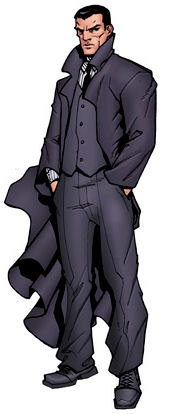 COMTE DE SAINT GERMAIN
COMTE DE SAINT GERMAIN
 COMTE DE SAINT GERMAIN
COMTE DE SAINT GERMAIN
Real Name: Unrevealed
Identity/Class: Human mutate/magic user; possibly Spanish
Occupation: Alchemist;
former adventurer, musician, spy, socialite
apparently a former agent of Dracula
Group Membership: Member of an unidentified group of immortals (Dr. John Dee, Dr. Francois Duvalier, Grigory Rasputin, Yi Yang, possibly others);
formerly alleged membership with the Freemasons, Knights Templar, Rosicrucians
Affiliations: Cagliostro, Count Charles of Hesse Cassel, King Louis XV, Franz Mesmer;
former servant of Dracula; directed the Toys
Enemies: Cammy Brandeis, Night Raven, Max Parrish, Johnny and Sue Storm, Zarathos
Known Relatives: None (see comments)
Aliases: Comte of St. Germain, der
Wundermann (German for "the Wonderman"), Marquis d'Aymar, Belmare;
possibly Ascended Master, Secret Master;
"Germonster" (insult via Johnny Storm)
Base of Operations: England and France
in the 18th Century;
possibly a number of countries over hundreds
to even thousands of years.
First Appearance: (Marvel Universe) Mighty World of Marvel II#17/3 (October, 1984);
<as alias of the Devil Doctor> Shang-Chi: Master of Kung
Fu#1 (November, 2002)
Powers/Abilities: St. Germain is allegedly immortal, unaging and may, like some fellow immortals, recover rapidly from otherwise fatal injuries.
St. Germain possesses a mastery of alchemy and various forms of non-traditional medicines. He is experienced as a historian and, allegedly, a magician; he is also a skilled violinist, composer, and painter. Multilingual, he speaks English, French, German, Italian, Portuguese and Spanish fluently. He is an adept in a number of forms of spiritualism.
St. Germain, sent by Dracula, was a non-human,
golem-type of creature (possibly created by the true St. Germain). This being was also likely immortal, but also
could transform into a type of earth elemental, able to generate electricity, grow in
size and strength (Class 50) by absorbing earth, brick, masonry, and other
minerals. He can also alter his form to some degree, sharpening his limbs into
razor-sharp points, etc. As an earth elemental, he is vulnerable to water, which
destroyed its physical integrity.
He did not appear to possess eyes, but instead used an
unidentified pair of orbs which he placed into his eye sockets,
perhaps when he wished to take an active role, or to assume his
earth elemental form.
He also controlled the Toys telepathically.
Height: 6' (variable)
Weight: 195 lbs. (variable)
Eyes: Unrevealed
Hair: Black
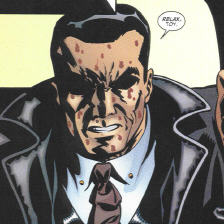
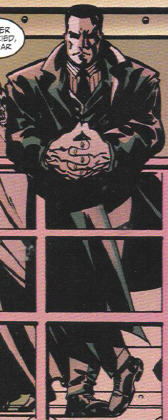 History:
History:
(History/Legend) - The Comte de Saint-Germain first emerged in
1745 England. In 1755, Saint-Germain showed up in Paris.
Insinuating himself into the aristocracy, he claimed to live
completely off of a strange elixir, which he sold at a large
price. Saint-Germain claimed he did not require food or beverage
to survive. He claimed to have lived during the Crusades, to have
known Richard the Lion-Hearted. The Comte seemed to die in 1782,
in the court of the Prince of Hesse Cassel. Of course, given his
alleged immortality, a sighting of him in 1821 Vienna reputedly
occurred, while in the book Souvenirs by Countess d'Adhemar
stated the Comte appeared in France in 1793. She claimed more
sightings up to 1820.
In 1845, Franz Graffer declared in his memoirs that he met
Saint-Germain, and stated that it came to his attention that the
Comte would appear in the Himalayas circa 1900. Circa 1900,
reputed sightings of the Comte in Tibet occurred. He had attained
the status of "ascended master" or "secret
master". In the 1930's, in California's Mount Shasta, an
appearance of the Comte tied to the "I AM" cult was
reported. In 1972, a man named Richard Chanfray claimed to be the
Comte. Chelsea Quinn Yarbro wrote a series of novels with the
Comte de Saint-Germain as a vampire.
For a more extensive account of the history of St. Germain, see the comments.
(Mighty World of Marvel II#17/3) - On the roof of a skyscraper, Night Raven witnessed the assassination of a mysterious white-robed man. He pursued the gunman, but lost the trail, and decided to investigate the building further to see if he could find any clues to the man's identity or why he might have been killed. He was able to determine that the penthouse and top floor were inhabited by a Dr. Francois Duvalier, but was attracting too much attention in the daylight. While he was waiting in the parking structure for nightfall, he saw the Comte De Saint Germain and Dr. John Dee arrive with a couple of bodyguards. He was confused by the way they knew Duvalier had been killed, yet spoke of him as though he were still alive. When he followed them up to the penthouse, he killed the two bodyguards, but was put into some kind of mystical trance by the living, breathing Duvalier.
(Savage Sword of Conan the Barbarian UK#85/3) - Duvalier used his magic to pry Night Raven's identity and history from his mind. Once the three men, who were all members of the loosely-knit community of immortals, realized he was the monster created by Yi Yang, they decided that she must decide his fate. And, unbeknownst to Night Raven, she had lived through the nuclear blast in Wisconsin, and came to New York at Saint Germain's call. Yi Yang spoke to Night Raven while he was still immobilized by Duvalier's ritual, telling him that it was too soon for him to know of the other immortals, and that he would destroy them all. Instead, she sent him back out into the world: "You're my guilt and you must walk the world until this pain and fear are worn from us..." When Night Raven awoke, he found himself on the top of the skyscraper, and wondered if he had dreamed everything that had happened since he first stood on the roof of the building.
(Before the Fantastic Four: The Storms#1) -
<Sometime shortly before the modern era> While
"dead" in the Pit of Death of Castle Dracula, Dracula's
spirit somehow managed to contact the Comte. St. Germain. Perhaps
unable to direct St. Germain to remove the stake from his chest,
Dracula instead sent him to obtain the Medallion of Zarathos,
which might be used to revive him indirectly. St. Germain
traveled by ship to America, and then by car (driven by one of
his Toys) to the funeral of Professor Henry Brandeis, who had
been incinerated after discovering and handling the Medallion.
The Medallion had also been handled by a young Johnny Storm, who
was not harmed by it, but had instead developed an affinity for
it. The Medallion suddenly appeared in Johnny's pocket while at
the funeral, and its sudden presence was noticed by St. Germain.
Terrified of the shadowy figure, Johnny fled into the woods,
where he was pursued by the Toys. With the aid of Susan Storm,
Cammy Brandeis (Henry's daughter), and Max Parrish (Henry's
brother-in-law), Johnny fought off the Toys long enough to escape
by car. St. Germain was physically pained by his failure: pain
which was transmitted and also felt by Dracula himself.
(Before F4: Storms#2) - While the family and friends of Professor
Brandeis researched the Medallion and the legend of St. Germain,
he sent his Toys after them again.
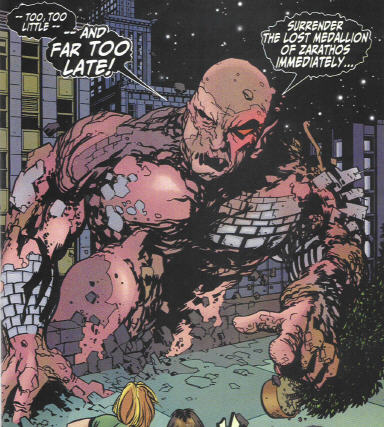 Parrish drew the Toys after himself by getting Johnny to
hand the Medallion off to him, knowing that it would momentarily
return to Johnny's pocket once again. The Toys were confused when
the Medallion vanished, and Parrish and Sue Storm escaped them
when the police arrived. However, St. Germain simply located
Parrish's address from the telephone directory and, alongside his
Toys, confronted all four of them in the lobby of Parrish's
apartment. Having placed certain orbs within his orbits, Germain
took on an inhuman form.
Parrish drew the Toys after himself by getting Johnny to
hand the Medallion off to him, knowing that it would momentarily
return to Johnny's pocket once again. The Toys were confused when
the Medallion vanished, and Parrish and Sue Storm escaped them
when the police arrived. However, St. Germain simply located
Parrish's address from the telephone directory and, alongside his
Toys, confronted all four of them in the lobby of Parrish's
apartment. Having placed certain orbs within his orbits, Germain
took on an inhuman form.
(Before F4: Storms#3) - Sue and Cammy again duped St. Germain and his toys by taking off with the Medallion, which again returned to Johnny Storm after he and Max Parrish had escaped by car. St. Germain then began to absorb extra mass from his surroundings and grew to great size, confronting Sue and Cammy on the roof of Parrish's building. The girls took advantage of St. Germain's weakness to water -- which they had recognized when he had been unable to pursue Johnny Storm himself during the funeral, where it had been raining -- and dove into the rooftop swimming pool to avoid him. At that same time, the spirit of Zarathos appeared before Johnny and Max, and convinced them that they would need his power to defeat St. Germain. As the giant creature shattered the pool, grabbed Sue, and knocked Cammy from the roof, Max accepted a union with Zarathos -- who had actually been more drawn to Johnny -- and became the Ghost Rider. Now possessed by the Spirit of Vengeance, Parrish drove up the side of the building on his motorcycle and rescued Cammy. He then rammed a hole through the giant St. Germain's chest, which, while allowing Sue to escape his grasp, had little other effect. Recognizing St. Germain's weakness to water, Parrish/Ghost Rider (holding the Medallion) led him across the rooftops, right through a water tower, which apparently washed away his earth elemental form.
Comments: Adapted by Jamie Delano and Ivan Allen.
Named as an alias of the Devil Doctor/Fu Manchu by Doug Moench
and Paul Gulacy.
CLARIFICATIONS:
Comte St. Germain, the Wonderman, has no known connections to:
The Toys have no known connection to:
Ghost Rider
The inclusion of the Ghost Rider further muddied the waters in
the origins and the differences between the various incarnations,
as typified by the original John Blaze/Zarathos/Ghost Rider and
the Dan Ketch/Noble Kale/Ghost Rider. I can't even begin to
explain it.
This entry deals mainly with the historical
version, and the version who appeared in the Before the
Fantastic Four: The Storms series. Fu Manchu and the character
used as a pawn of Dracula are certainly different characters.
Whether either of these is or was the Saint Germain of legend is
up for debate.
The version used by Dracula seemed to have almost nothing in
common with the character from legend, as if Kavanaugh had chosen
the name solely for its effect and paid little attention to the
character. Kavanaugh's version was more a monstrous, golem-type
creature than some zen mystic. This being is described as
belonging body and soul, as he always has, to the beast who owns
him <Dracula>. One might suspect that Dracula or his
followers conjured some Earth elemental, imbued it with magical
power, and gave it the name of St. Germain. Alternatively,
perhaps the magic of Dracula's followers and the energy derived
from the Amulet/Medallion of Zarathos corrupted and altered the
otherwise human St Germain.
Anyway, either neither of the two seen in the MU is the original,
the accounts of the original are wrong, or there's been some
major changes. Someone's got some 'splainin to do!
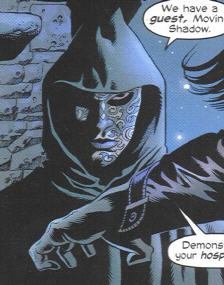
(Master of Kung Fu II#1-6) - St. Germain was seen working on a plot to harness the energy described by Nikolai Tesla as a weapon. This man was unmasked by Leiko Wu and revealed to be none other than the Devil Doctor, Fu Manchu.
Per Nick, the Squid:
Fu Manchu claims in Master of Kung Fu II#3 (MAX series) that
he has had many aliases over the centuries and that he was always
the Comte de Saint Germain, one of his adopted personas. If
this is true, it begs the question of how old the Devil Doctor
truly is.
Instead of being born in the 19th century, according to the Wold
Newton Universe, he would have to be at least 300 years old!
Also, he appears the have adopted Saint
Germain as his permanent name, no doubt due to the copyright
restrictions alone.
There is also a website: www.geocities.com/Hollywood/Park/5109/whovian.html that has some more information on Saint Germain,
including conjecture on his being a time-traveller or the
"wandering Jew" from European apocrypha.
I have no idea how accurate it is, however.
Thanks to John McDonagh for contributing the legendary information described in the History section above.
If you read the info below, the role of St. Germain in the court of St. Louis seems to be very similar to the role given to Dracula in the MU.
Here's a ton of info, derived from: http://www.crystalinks.com/germain.html
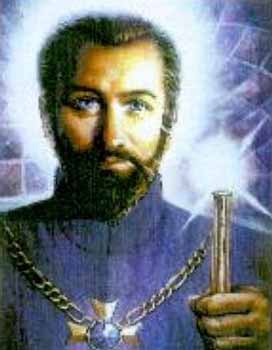
Comte de Saint Germain was an 18th-century adventurer known as 'Der Wundermann' - 'The Wonderman'.
He was a man whose origin was unknown and who disappeared without leaving a trace.
His presumed date of birth was 1690. He supposed died in 1784, but many people in Europe saw him after that date. A few believe that he still lives on. I am one of those people.
The commonest hypothesis about his birth is that Saint-Germain was the natural son of the widow of Charles II of Spain and a certain Comte (Count) Adanero, whom she knew at Bayonne. This Spanish queen was Marie de Neubourg, whom Victor Hugo took as the heroine of his Ruy Blas. Those who disliked Saint-Germain said that he was the son of a Portuguese Jew named Aymar, while those who hated him said, in the effort to add to his discredit, that he was the son of an Alsatian Jew named Wolff.
Fairly recently a new genealogy of Saint-Germain has been put forward which seems the most probable of all. It is the work of the theosophists and Annie Besant, who has frequently made the statement that the Comte de Saint-Germain was one of the sons of Francis Racoczi II, Prince of Transylvania. The children of Francis Racoczi were brought up by the Emperor of Austria, but one of them was withdrawn from his guardianship.
Saint Germain never seemed to age. For an entire century he maintained the physical appearance of a man between forty and fifty years old.
He could do just about anything. He was almost too good to be true. He was a magician, a musician, artistry as a violinist, talent as a painter, skill in alchemy and chemistry, a seer who read for and socialized with the rich and famous, had great wealth, and was one of the most mysterious men on the Europe continent. He knew nearly all the European languages. His knowledge of history was comprehensive, and his accomplishments as a chemist, on which he based his reputation, were in many ways considerable.
By far the greatest obvious talents of the Comte de Saint-Germain were connected with his knowledge of alchemy. Yet if Saint-Germain he knew how to make gold, he was wise enough to say nothing about it. Nothing but the possession of this secret could perhaps account for the enormous wealth at his command, though he was not known to have money on deposit at any banks.
He was one of the of the most celebrated mystics and adventurers of modern times. He was a confidant of two kings of France, a dazzlingly rich and gifted social figure, the subject of a thousand rumors.
He enjoyed and sought the company of the pretty women of his day. It appears from the memoirs of Baron von Gleichen that when Saint-Germain was in Paris he became the lover of Mademoiselle Lambert, daughter of the Chevalier Lambert, who lived in the house in which he lodged. And it appears from Grosley's memoirs that in Holland he became the lover of a woman as rich and mysterious as himself.
Though he never ate any food in public, he liked dining out because of the people he met and the conversations he heard. They say he lived on oatmeal. He had an immense stock of amusing stories with which he regaled society.
He was an aristocrat who lived with princes and even with kings almost on a footing of an equal.
He gave recipes for removing wrinkles and dyeing hair.
His activity and the diversity of his occupations were very great. He was interested in the preparation of dyes and even started a factory in Germany for the manufacture of felt hats.
One of his principal roles was that of a secret agent in international politics in the service of France. He became Louis XV's confidential and intimate counselor and was entrusted by him with various secret missions.
He had a love of jewels in an extreme form, and he ostentatiously showed off those he possessed. He kept a great quantity of them in a casket, which he carried about everywhere with him. The importance he attached to jewels was so great that in the pictures painted by him, which were in themselves remarkable, the figures were covered with jewels; and his colors were so vivid and strange that faces looked pale and insignificant by contrast. Jewels cast their reflection on him and threw a distorting light on the whole of his life.
He was also known to carry jewels sewn into his clothing . He was said to have presented a cross ornamented with gems to a woman he scarcely knew, because she had idly admired it.
The count claimed that he had learned how to turn several small diamonds into one large one and to make pearls grow to spectacular size. He said he could remove flaws from diamonds. He could make a big diamond out of several small stones. The diamonds that he wore in his shoes and garters were believed to be worth more than 200,000 francs.
It was widely suspected that he also knew the secret for making gold out of base metal.
Tradition has related that he said he had known Jesus and been present at the Council of Nicea. But he did not go so far as this in his contempt for the men with whom he associated and in his derision of their credulity.
He seems to have become a celebrity in the 1750's as a friend of Louis XV and his mistress Madame de Pompadour, who together spent evenings with him simply for the pleasure of his conversation. Louis XV must have known who he was, for he extended to him a friendship that aroused the jealousy of his court. He allotted him rooms in the Chateau of Chambord. He shut himself up with Saint-Germain and Madam de Pompadour for whole evenings; and the pleasure he derived from his conversation and the admiration he no doubt felt for the range of his knowledge cannot explain the consideration, almost the deference, he had for him. Madam du Housset says in her memoirs that the king spoke of Saint-Germain as a personage of illustrious birth.
Count Charles of Hesse Cassel, with whom he lived during the last years in which history is able to follow his career, must also have possessed the secret of his birth. They worked with alchemy together. Saint-Germain treated him as an equal. It was to him that Saint-Germain entrusted his paper just before his supposed death in 1784.
However, neither Louis XV nor the Count of Hesse Cassel ever revealed anything about the birth of Saint-Germain. The count even went so far as invariably to withhold the smallest detail bearing on the life of his mysterious friend. This is a very remarkable fact, since Saint-Germain was an extremely well known figure.
Whether he was a genius or a charlatan, Saint-Germain had the talent to make himself noticed and the subject of gossip. But in Versailles and Paris he was embraced as the confidential adviser of Louis XV. The position earned him the envy and enmity of the king's ministers, who denounced him as an adventurer with a smooth line of talk.
Matters came to a head in 1760, when the count at the behest of the king involved himself in foreign affairs, going behind the back of ministry. Threatened with arrest, he was obliged to flee to England, where he stayed for a while; possibly for a period of two years.
From England Count Saint-Germain apparently went to Russia, where it is claimed he took part in a conspiracy that put Catherine the Great upon the throne in 1762.
After that nothing much is known of the count until 1774, when Louis XVI and Marie Antoinette came to the throne. Saint-Germain then returned to France. It is said that he warned the royal couple of the revolution 15 years in the future, saying, "There will be a blood-thirsty republic, whose scepter will be the executioner's knife."
Secret Societies
Secret societies were the fashion in pre-Revolutionary France, and some of them recognized Saint-Germain as an 'adept' one who knew the ancient wisdoms hinted at in the rites of the Freemasons, Rosicrucians and Knights Templars.
He influenced Freemasonry and the secret societies, though many modern masons have denied this and have even omitted to mention him as a great source of inspiration.
In Vienna he took part in the foundation of the Society of Asiatic Brothers and of the Knights of Light, who studied alchemy; and it was he who gave Mesmer his fundamental ideas on personal magnetism and hypnotism. It is said that he initiated Cagliostro, who visited him on several occasions in Holstein to receive directions from him, though there is no direct evidence for this. The two men were to be far separated from one another by opposite currents and a different fate.
All over the country secret societies sprang up. The new spirit manifested itself in the form of associations. Neither the nobility nor the clergy escaped what had become a fashion.
There were lodges for women, and the Princesse de Lamballe became grand mistress of one of them.
In Germany there were the Illuminati and the Knights of Strict Observance, and Frederick II, when he came to the throne, founded the sect of the Architects of Africa.
In France, the Order of the Templars was reconstituted, and Freemasonry, whose grand master was the Duke de Chartres, increased the number of its lodges in every town. Martinez de Pasqually taught his philosophy at Marseilles, Bordeaux and Toulouse; and Savalette de Lange, with mystics such as Court de Gebelin and Saint-Martin, founded the lodge of the Friends Assembled.
The initiates of these sects understood that they were the depositories of a heritage that they did not know, but whose boundless value they guessed; it was to be found somewhere, perhaps in traditions, perhaps in a book written by a master, perhaps in themselves. They spoke of this revealing word, this hidden treasure it was said to be in the hands of "unknown superiors of these sects, who would one day disclose the wealth which gives freedom and immortality."
It was this immortality of the spirit that Saint-Germain tried to bring to a small group of chosen initiates. He believed that this minority, once it was developed itself, would, in its turn, help to develop another small number, and that a vast spiritual radiation would gradually descend, in beneficent waves, towards the more ignorant masses. It was a sage's dream, which was never to be realized.
With the co-operation of Savalette de Lange, who was the nominal head, he founded the group of Philalethes, or truth-lovers, which was recruited from the cream of the Friends Assembled. The Prince of Hesse, Condorcet, and Cagliostro were all members of this group. Saint-Germain expounded his philosophy at Ermenonville and in Paris, in the rue Platriere. It was a Platonic Christianity, which combined Swedenborg's visions with Martinez de Pasqually's theory of reintegration. There were to be found in it Plotinus' emanations and the hierarchy of successive planes described by Hermeticists and modem theosophists. He taught that man has in him infinite possibilities and that, from the practical point of view, he must strive unceasingly to free himself of matter in order to enter into communication with the world of higher intelligences.
He was understood by some. In two great successive assemblies, at which every Masonic lodge in France was represented, the Philalethes attempted the reform of Freemasonry. If they had attained their aim, if they had succeeded in directing the great force of Freemasonry by the prestige of their philosophy, which was sublime and disinterested, it may be that the course of events would have been altered, that the old dream of a world guided by philosopher-initiates would have been realized.
But matters were to turn out differently. Old causes, created by accumulated injustices had paved the way for terrible effects. These effects were in their turn to create the causes of future evil. The chain of evil, linked firmly together by men's egoism and hatred, was not to be broken. The light kindled by a few wise visionaries, a few faithful watchers over the well being of their brothers, was extinguished almost as soon as it was kindled.
Saint-Germain's Death
Secluded at Eckenforn in the count's castle, Saint-Germain announced that he was tired of fife. He seemed careworn and melancholy. He said he felt feeble, but he refused to see a doctor and was tended only by women. No details exist of his death, or rather of his supposed death. No tombstone at Eckenforn bore his name. It was known that he had left all his papers and certain documents relating to Freemasonry to the Count of Hesse Cassel.
The count for his part asserted that he had lost a very dear friend. But his attitude was highly equivocal. He refused to give any information about his friend or his last moments, and turned the conversation if anyone spoke of him. His whole behavior gives color to the supposition that he was the accomplice of a pretended death.
Although, on the evidence of reliable witnesses, he must have been at least a hundred years old in 1784, his death in that year cannot have been genuine. The official documents of Freemasonry say that in 1785 the French masons chose him as their representative at the great convention that took place in that year, with Mesmer, Saint-Martin, and Cagliostro present. In the following year Saint-Germain was received by the Empress of Russia. Finally, the Comtesse d'Adhemar reports at great length a conversation she had with him in 1789 in the Church of the Recollets, after the taking of the Bastille.
His face looked no older than it had looked thirty years earlier. He said he had come from China and Japan. "There is nothing so strange out there," he said, "as that which is happening here. But I can do nothing. My hands are tied by someone who is stronger than I. There are times when it is possible to draw back; others at which the decree must be carried out as soon as he has pronounced it."
And he told her in broad outlines all the events, not excepting the death of the queen, that were to take place in the years that followed. "The French will play with titles and honors and ribbons like children. They will regard everything as a plaything, even the equipment of the Garde Nationale. There is today a deficit of some forty millions, which is the nominal cause of the Revolution. Well, under the dictatorship of philanthropists and orators the national debt will reach thousands of millions."
"I have seen Saint-Germain again," wrote Comtesse d'Adhemar in 1821, "each time to my amazement. I saw him when the queen was murdered, on the 18th of Brumaire, on the day following the death of the Duke d'Enghien, in January, 1815, and on the eve of the murder of the Duke de Berry."
Mademoiselle de Genlis asserts that she met the Comte de Saint-Germain in 1821 during the negotiations for the Treaty of Vienna; and the Comte de Chalons, who was ambassador in Venice, said he spoke to him there soon afterwards in the Piazza di San Marco. There is other evidence, though less conclusive, of his survival. The Englishman Grosley said he saw him in 1798 in a revolutionary prison; and someone else wrote that he was one of the crowd surrounding the tribunal at which the Princess de Lamballe appeared before her execution.
It seems quite certain that the Comte de Saint-Germain did not die at the place and on the date that history has fixed. He continued an unknown career, of whose end we are ignorant and whose duration seems so long that one's imagination hesitates to admit it.
What happened to the Comte de Saint-Germain after 1821, in which year there is evidence that he was still alive? An Englishman, Albert Vandam, in his memoirs, which he calls An Englishman in Paris, speaks of a certain person whom he knew towards the end of Louis Philippe's reign and whose way of life bore a curious resemblance to that of the Comte de Saint-Germain.
"He called himself Major Fraser, wrote Vandam, "lived alone and never alluded to his family. Moreover he was lavish with money, though the source of his fortune remained a mystery to everyone. He possessed a marvelous knowledge of all the countries in Europe at all periods. His memory was absolutely incredible and, curiously enough, he often gave his hearers to understand that he had acquired his learning elsewhere than from books. Many is the time he has told me, with a strange smile, that he was certain he had known Nero, had spoken with Dante, and so on."
Like Saint-Germain, Major Fraser had the appearance of a man of between forty and fifty, of middle height and strongly built. The rumor was current that he was the illegitimate son of a Spanish prince. After having been, also like Saint-Germain, a cause of astonishment to Parisian society for a considerable time, he disappeared without leaving a trace. Was it the same Major Fraser who, in 1820, published an account of his journey in the Himalayas, in which he said he had reached Gangotri, the source of the most sacred branch of the Ganges River, and bathed in the source of the Jumna River?
It was at the end of the nineteenth century that the legend of Saint-Germain grew so inordinately. By reason of his knowledge, of the integrity of his life, of his wealth and of the mystery that surrounded him, he might reasonably have been taken for an heir of the first Rosicrucians, for a possessor of the Philosopher's Stone. But the theosophists and a great many occultists regarded him as a master of the great White Lodge of the Himalayas. The legend of these masters is well known. According to it there live in inaccessible lamaseries in Tibet certain wise men who possess the ancient secrets of the lost civilization of Atlantis. Sometimes they send to their imperfect brothers, who are blinded by passions and ignorance, sublime messengers to teach and guide them. Krishna, the Buddha, and Jesus were the greatest of these. But there were many other more obscure messengers, of whom Saint-Germain has been considered to be one.
"This pupil of Hindu and Egyptian hierophants, this holder of the secret knowledge of the East," theosophist Madam Blavatsky says of him, "was not appreciated for who he was. The stupid world has always treated in this way men who, like Saint-Germain, have returned to it after long years of seclusion devoted to study with their hands full of the treasure of esoteric wisdom and with the hope of making the world better, wiser and happier." Between 1880 and 1900 it was admitted among all theosophists, who at that time had become very numerous, particularly in England and America, that the Comte de Saint-Germain was still alive, that he was still engaged in the spiritual development of the West, and that those who sincerely took part in this development had the possibility of meeting him.
The brotherhood of Khe-lan was famous throughout Tibet, and one of their most famous brothers was an Englishman who had arrived one day during the early part of the twentieth century from the West. He spoke every language, including the Tibetan, and knew every art and science, says the tradition. His sanctity and the phenomena produced by him caused him to be proclaimed a Shaberon Master after a residence of but a few years. His memory lives to the present day among the Tibetans, but his real name is a secret with the Shaberons alone. Might not this mysterious traveler be the Comte de Saint-Germain?
But even if he has never come back, even if he is no longer alive and we must relegate to legend the idea that the great Hermetic nobleman is still wandering about the world with his sparkling jewels, his senna tea, and his taste for princesses and queens even so it can be said that he has gained the immortality he sought. For a great number of imaginative and sincere men the Comte de Saint-Germain is more alive than he has ever been. There are men who, when they hear a step on the staircase, think it may perhaps be he, coming to give them advice, to bring them some unexpected philosophical idea. They do not jump up to open the door to their guest, for material barriers do not exist for him. There are men who, when they go to sleep, are pervaded by genuine happiness because they are certain that their spirit, when freed from the body, will be able to hold converse with the master in the luminous haze of the astral world.
These beings appeared to be semi-human and were
controlled by St. Germain, both directly and telepathically. They
did not appear to possess significant superhuman physical powers
or particular fighting skills, but tended to overwhelm their
objective by strength of numbers. Whether they were inhuman
golems, soulless zombies, or normal people under St. Germain's
control is unknown.
They appeared to vanish after St. Germain was seemingly
destroyed.
--Before the Fantastic Four: The Storms#1 (2, 3
Appearances:
Mighty World of Marvel II#17/3 (October, 1984) - Jamie Delano (writer), Ivan Allen (artist)
Savage Sword of Conan the Barbarian UK#85/3 (November, 1984)
Before the Fantastic Four: The Storms#1-3 (December, 2000 - February, 2001) - Terry Kavanagh (writer), Charles Adlard (artist), Bobbie Chase (editor)
First Posted: 12/15/2002
Last updated: 09/03/2016
Any Additions/Corrections? please let me know.
Fu Manchu and related characters are property
of the Sax Rohmer estate.
All other characters mentioned or pictured are
™ and © 1941-2099 Marvel Characters, Inc. All Rights
Reserved. If you like this stuff, you should check out the real
thing!
Please visit The Marvel Official Site at: http://www.marvel.com
Special Thanks to www.g-mart.com for hosting the Appendix, Master List, etc.!